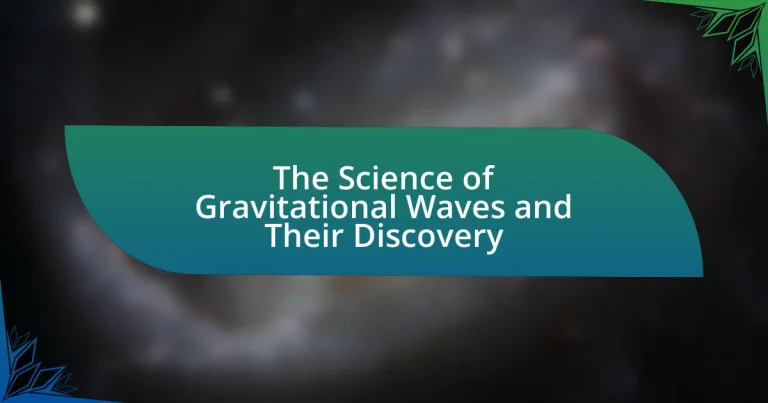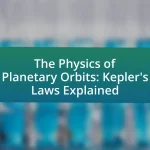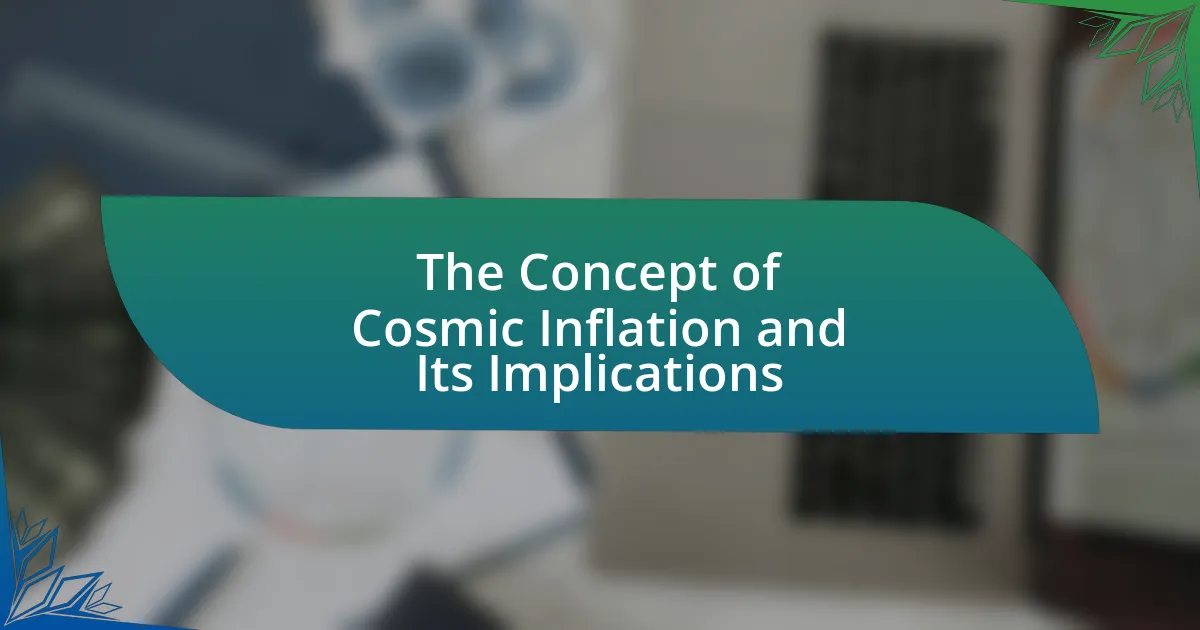Gravitational waves are ripples in spacetime generated by the acceleration of massive objects, such as merging black holes and neutron stars, first predicted by Albert Einstein in 1916. The first direct detection of these waves by the LIGO observatory in 2015 confirmed their existence and marked a significant advancement in astrophysics. This article explores the production of gravitational waves, the astronomical events that generate them, their significance in physics, and the technological advancements that enabled their detection. It also discusses the implications of gravitational wave research for science and technology, including potential applications in various fields and the societal benefits derived from this groundbreaking discovery.
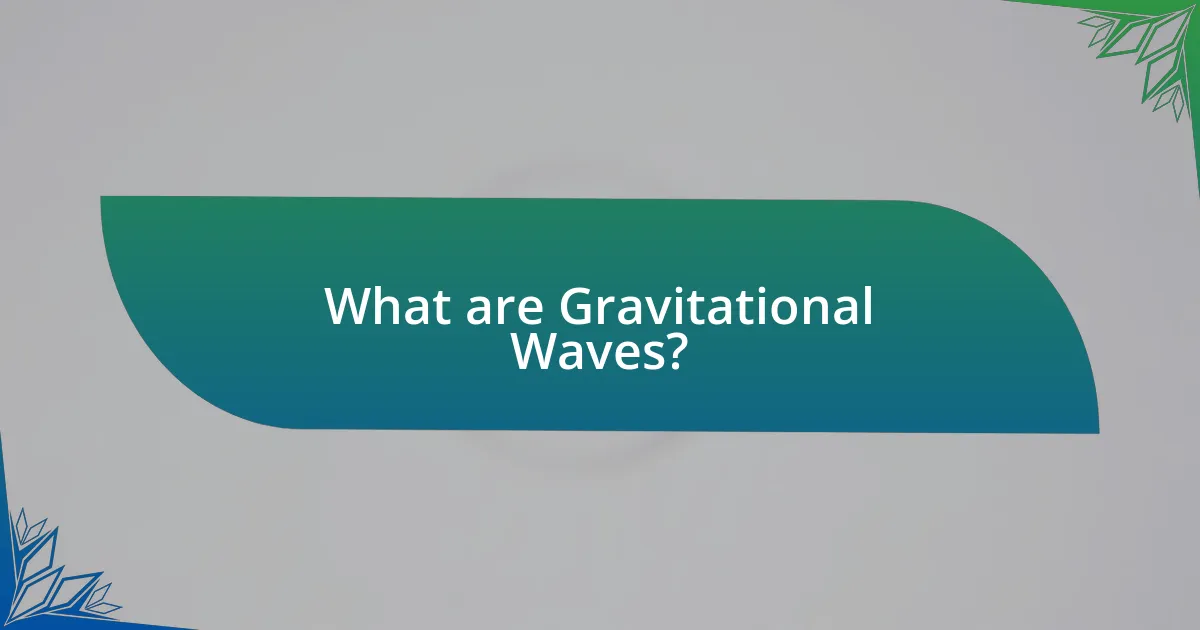
What are Gravitational Waves?
Gravitational waves are ripples in spacetime caused by the acceleration of massive objects, such as merging black holes or neutron stars. These waves propagate at the speed of light and were first predicted by Albert Einstein in 1916 as part of his general theory of relativity. The existence of gravitational waves was confirmed in 2015 by the LIGO observatory when it detected waves generated by the merger of two black holes, marking a significant milestone in astrophysics and providing a new way to observe the universe.
How are Gravitational Waves produced?
Gravitational waves are produced by the acceleration of massive objects, particularly during events such as the merging of black holes or neutron stars. When these massive bodies accelerate, they create ripples in spacetime that propagate outward at the speed of light. The first direct detection of gravitational waves by the LIGO observatory in 2015 confirmed their existence, originating from a binary black hole merger approximately 1.3 billion light-years away. This detection provided concrete evidence of gravitational waves, aligning with predictions made by Albert Einstein’s general theory of relativity.
What astronomical events generate Gravitational Waves?
Gravitational waves are generated by astronomical events that involve the acceleration of massive objects, particularly during the merger of compact binary systems. Notable examples include the collision and merger of black holes, which was first detected by LIGO in 2015, and the merger of neutron stars, observed in 2017. These events create ripples in spacetime due to the intense gravitational fields involved, leading to detectable gravitational waves. The detection of these waves provides direct evidence of such cosmic phenomena and enhances our understanding of the universe.
How do the properties of these events influence the waves?
The properties of astronomical events, such as merging black holes or neutron stars, significantly influence the characteristics of gravitational waves produced. These events determine the amplitude, frequency, and duration of the waves, which are directly related to the mass and velocity of the objects involved. For instance, the merger of two black holes generates stronger gravitational waves due to their massive nature, resulting in higher amplitude signals detectable by observatories like LIGO. Additionally, the frequency of the waves is influenced by the speed at which the objects spiral towards each other before merging, with faster mergers producing higher frequency waves. This relationship between event properties and wave characteristics is supported by the observations made during the first detection of gravitational waves from the merger of two black holes in 2015, which confirmed predictions made by Einstein’s general relativity.
Why are Gravitational Waves significant in physics?
Gravitational waves are significant in physics because they provide a new way to observe and understand the universe, confirming key predictions of Einstein’s general theory of relativity. Their detection, first achieved by the LIGO observatory in 2015, marked a groundbreaking moment in astrophysics, allowing scientists to study cosmic events such as black hole mergers and neutron star collisions. This capability enhances our understanding of fundamental physics, including the nature of gravity and the behavior of matter under extreme conditions, thereby expanding the frontiers of knowledge in both theoretical and observational astronomy.
What insights do Gravitational Waves provide about the universe?
Gravitational waves provide insights into the dynamics of massive astronomical events, such as black hole mergers and neutron star collisions. These waves allow scientists to observe phenomena that are otherwise invisible through traditional electromagnetic observations. For instance, the detection of gravitational waves from the merger of two black holes by LIGO in 2015 confirmed predictions made by Einstein’s General Theory of Relativity and opened a new era of astrophysics known as gravitational wave astronomy. This discovery has enabled researchers to study the properties of black holes, the rate of their formation, and the behavior of matter under extreme conditions, thus enhancing our understanding of the universe’s evolution and structure.
How do they challenge existing theories in physics?
Gravitational waves challenge existing theories in physics by providing empirical evidence that supports the predictions of general relativity while simultaneously revealing limitations in classical physics. The detection of gravitational waves by LIGO in 2015 confirmed that massive accelerating objects, such as merging black holes, produce ripples in spacetime, which were previously only theoretical. This discovery not only validated Einstein’s predictions but also highlighted gaps in our understanding of gravity, particularly in extreme conditions where quantum mechanics and general relativity intersect. The ongoing study of gravitational waves continues to test the boundaries of established theories, prompting physicists to explore new frameworks that could unify gravity with quantum mechanics.
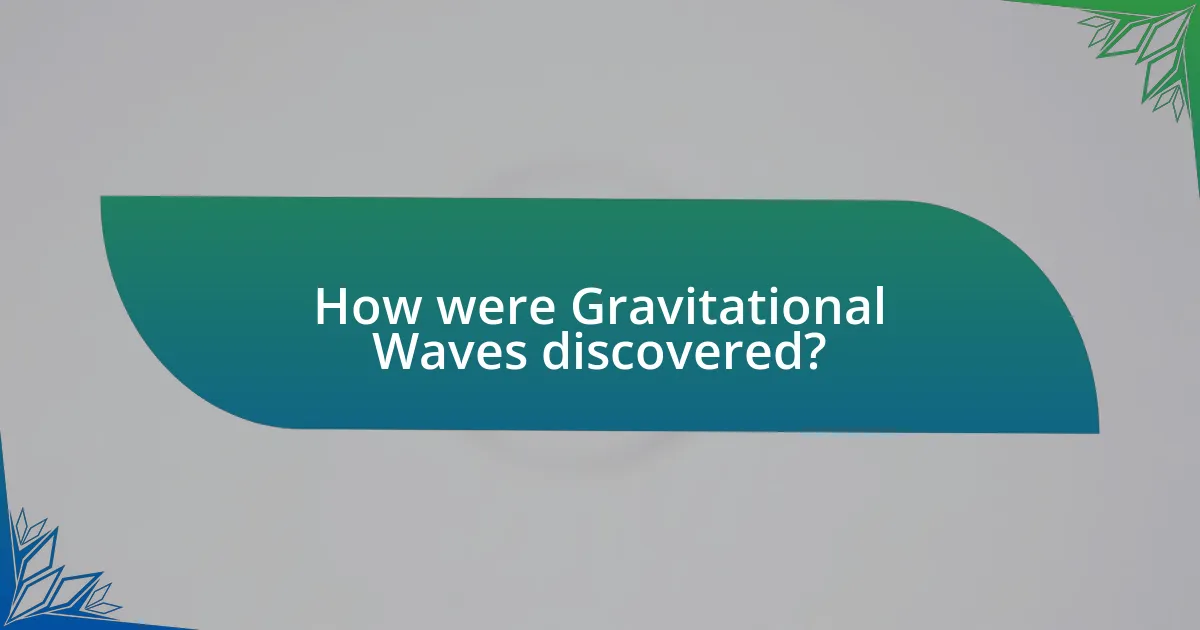
How were Gravitational Waves discovered?
Gravitational waves were discovered through the direct detection by the LIGO (Laser Interferometer Gravitational-Wave Observatory) in September 2015. This groundbreaking achievement confirmed a prediction made by Albert Einstein in 1916 as part of his general theory of relativity, which posited that massive accelerating objects, such as merging black holes, would create ripples in spacetime. The LIGO detectors utilized laser interferometry to measure minute changes in distance caused by passing gravitational waves, achieving sensitivity to displacements smaller than a proton’s diameter. The first detected event, known as GW150914, involved the merger of two black holes approximately 1.3 billion light-years away, marking a significant milestone in astrophysics and the study of gravitational waves.
What experiments led to the detection of Gravitational Waves?
The experiments that led to the detection of gravitational waves were primarily conducted by the Laser Interferometer Gravitational-Wave Observatory (LIGO). LIGO’s first successful detection occurred on September 14, 2015, when it observed gravitational waves from the merger of two black holes. This groundbreaking event was confirmed through the precise measurements of changes in the distance between mirrors placed 4 kilometers apart, which were caused by passing gravitational waves. The significance of this detection was further validated by the scientific community, as it matched predictions made by Einstein’s General Theory of Relativity, demonstrating the existence of gravitational waves as ripples in spacetime.
What role did LIGO play in this discovery?
LIGO played a crucial role in the discovery of gravitational waves by being the first observatory to detect these ripples in spacetime. On September 14, 2015, LIGO recorded the gravitational waves produced by the merger of two black holes, marking the first direct observation of such phenomena. This detection confirmed a key prediction of Albert Einstein’s general theory of relativity and opened a new era in astrophysics, allowing scientists to observe cosmic events that were previously undetectable. The significance of LIGO’s role is underscored by its advanced laser interferometry technology, which enabled the precise measurement of the minuscule changes in distance caused by passing gravitational waves, demonstrating its effectiveness in capturing these groundbreaking events.
How did technology evolve to enable this detection?
Technology evolved significantly to enable the detection of gravitational waves through advancements in laser interferometry and precision measurement techniques. The development of the Laser Interferometer Gravitational-Wave Observatory (LIGO) in the early 2000s exemplifies this evolution, utilizing high-powered lasers and sophisticated optics to measure minute changes in distance caused by passing gravitational waves. LIGO’s sensitivity was enhanced by innovations such as seismic isolation systems, which minimized environmental noise, and advanced data analysis algorithms that improved signal detection amidst background noise. These technological advancements culminated in the first direct detection of gravitational waves in September 2015, confirming predictions made by Einstein’s General Theory of Relativity and marking a significant milestone in astrophysics.
What were the key milestones in the discovery process?
The key milestones in the discovery process of gravitational waves include the prediction of their existence by Albert Einstein in 1916, the first indirect detection of gravitational waves from a binary pulsar system by Russell Hulse and Joseph Taylor in 1974, and the direct detection of gravitational waves by the LIGO observatory on September 14, 2015. Einstein’s theory of general relativity laid the groundwork for understanding gravitational waves, while Hulse and Taylor’s work provided empirical evidence supporting their existence. The LIGO detection confirmed the existence of gravitational waves, originating from the merger of two black holes, marking a significant breakthrough in astrophysics and confirming a century-old prediction.
What were the challenges faced during the detection efforts?
The challenges faced during the detection efforts of gravitational waves included technological limitations, environmental noise, and the need for extreme sensitivity. Technological limitations arose from the requirement for highly advanced detectors, such as LIGO, which needed to measure displacements smaller than a proton’s diameter. Environmental noise, including seismic activity and thermal fluctuations, interfered with the detection signals, complicating the identification of genuine gravitational wave events. Additionally, achieving the necessary sensitivity to detect these faint signals required significant advancements in laser technology and optics, as well as extensive data analysis techniques to differentiate between noise and actual gravitational wave signals.
How did the scientific community react to the discovery?
The scientific community reacted with widespread excitement and validation to the discovery of gravitational waves, confirming a key prediction of Einstein’s general theory of relativity. This landmark event, announced by the LIGO collaboration in February 2016, was met with accolades from physicists worldwide, as it opened a new era in astrophysics and provided a novel way to observe cosmic events. The detection of gravitational waves from merging black holes was hailed as a monumental achievement, leading to numerous publications and discussions in scientific journals, conferences, and media outlets, underscoring its significance in enhancing our understanding of the universe.
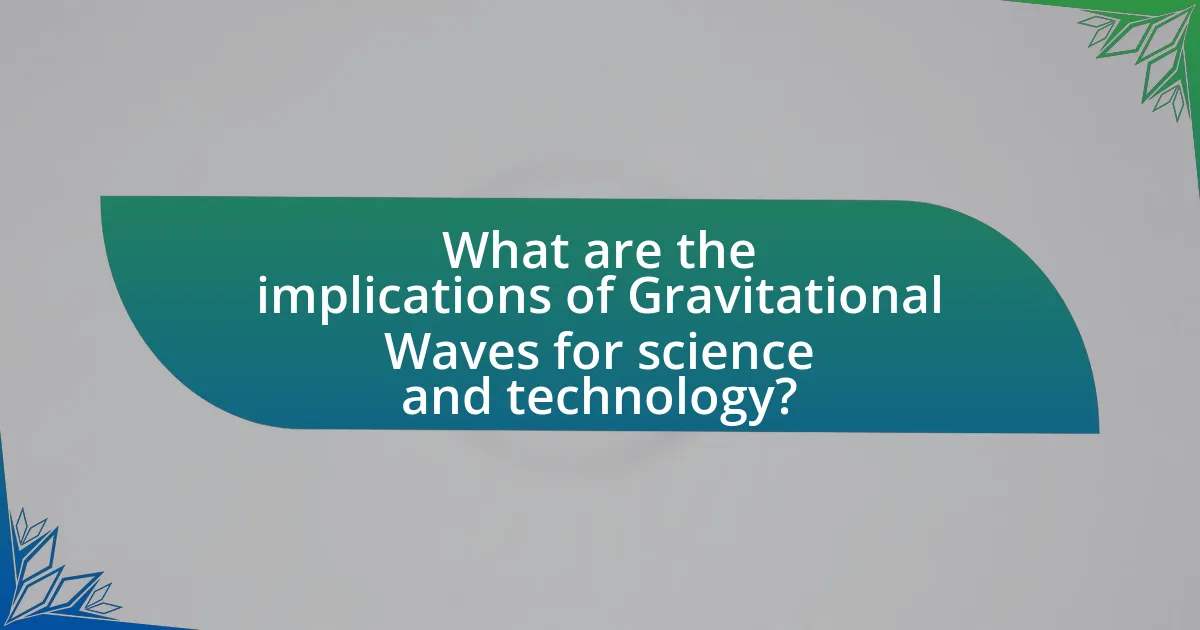
What are the implications of Gravitational Waves for science and technology?
Gravitational waves have significant implications for science and technology, primarily by enhancing our understanding of the universe and advancing detection technologies. The detection of gravitational waves, first confirmed by LIGO in 2015, has opened a new observational window in astrophysics, allowing scientists to study phenomena such as black hole mergers and neutron star collisions. This has led to groundbreaking insights into the nature of gravity, the behavior of extreme matter, and the dynamics of cosmic events.
Moreover, the technology developed for gravitational wave detection has broader applications, including improvements in precision measurement techniques and advancements in data analysis methods. For instance, the laser interferometry technology used in LIGO has potential applications in fields such as telecommunications and materials science. The collaboration and data-sharing practices established among international research teams also foster innovation and interdisciplinary research, further driving technological advancements.
In summary, the implications of gravitational waves extend beyond astrophysics, influencing various scientific fields and technological innovations through enhanced observational capabilities and advanced measurement techniques.
How do Gravitational Waves enhance our understanding of the cosmos?
Gravitational waves enhance our understanding of the cosmos by providing a new method to observe astronomical events that are otherwise invisible to traditional telescopes. These ripples in spacetime, first detected by LIGO in 2015, allow scientists to study phenomena such as black hole mergers and neutron star collisions, revealing information about their properties and behaviors. For instance, the observation of the merger of two black holes confirmed predictions made by Einstein’s General Theory of Relativity, demonstrating the waves’ ability to validate existing theories. Additionally, gravitational waves carry unique signatures of their sources, enabling researchers to gain insights into the formation and evolution of cosmic structures, thus expanding our knowledge of the universe’s history and dynamics.
What new research areas have emerged from Gravitational Wave astronomy?
New research areas that have emerged from Gravitational Wave astronomy include multi-messenger astronomy, the study of neutron star mergers, and the investigation of black hole populations. Multi-messenger astronomy combines gravitational wave data with electromagnetic observations, enhancing our understanding of cosmic events. The study of neutron star mergers has provided insights into the formation of heavy elements, as evidenced by the kilonova associated with the GW170817 event. Additionally, the investigation of black hole populations has led to new models of stellar evolution and the dynamics of binary systems, as highlighted by the detection of numerous black hole mergers by LIGO and Virgo.
How might Gravitational Waves influence future space exploration?
Gravitational waves may significantly influence future space exploration by providing new methods for detecting and understanding cosmic events. These ripples in spacetime, first observed in 2015 by the LIGO observatory, allow scientists to study phenomena such as black hole mergers and neutron star collisions, which were previously undetectable through traditional electromagnetic observations. The ability to detect gravitational waves can lead to enhanced navigation techniques for spacecraft, as well as improved models of the universe’s structure and evolution, ultimately guiding missions to unexplored regions of space. Furthermore, ongoing advancements in gravitational wave astronomy, such as the planned space-based observatory LISA (Laser Interferometer Space Antenna), will expand our observational capabilities, enabling the exploration of the universe’s most energetic events and contributing to a deeper understanding of fundamental physics.
What practical applications could arise from Gravitational Wave research?
Gravitational wave research could lead to advancements in astrophysics, precision measurements, and technology development. The detection of gravitational waves provides insights into cosmic events, such as black hole mergers and neutron star collisions, enhancing our understanding of the universe. This research can improve technologies like GPS and telecommunications by refining the precision of timekeeping systems, as gravitational wave detectors require highly accurate timing mechanisms. Additionally, the techniques developed for analyzing gravitational waves may have applications in other fields, such as medical imaging and materials science, where precise measurements are crucial.
How can Gravitational Wave technology be utilized in other fields?
Gravitational wave technology can be utilized in fields such as astrophysics, medical imaging, and seismic monitoring. In astrophysics, the technology enhances the detection of cosmic events, allowing scientists to study phenomena like black hole mergers and neutron star collisions, which provide insights into the universe’s evolution. In medical imaging, similar techniques can improve the resolution of imaging systems, potentially leading to better diagnostic tools. Additionally, in seismic monitoring, gravitational wave detectors can help identify and analyze seismic activities, contributing to earthquake research and safety measures. These applications demonstrate the versatility of gravitational wave technology beyond its original purpose in astronomy.
What are the potential benefits for society from this research?
The potential benefits for society from the research on gravitational waves include advancements in our understanding of the universe, which can lead to technological innovations and improved scientific literacy. This research enhances our knowledge of fundamental physics, particularly in areas such as general relativity and astrophysics, which can inspire new technologies, similar to how the development of GPS technology was influenced by relativity. Furthermore, the detection of gravitational waves has fostered international collaboration among scientists, promoting a culture of teamwork and shared knowledge that can benefit various fields beyond astrophysics.
What are the best practices for engaging with Gravitational Wave research?
The best practices for engaging with Gravitational Wave research include collaborating with established research institutions, participating in relevant conferences, and utilizing open-access data from observatories like LIGO and Virgo. Collaboration with institutions such as the California Institute of Technology and the Massachusetts Institute of Technology enhances access to expertise and resources. Attending conferences like the Gravitational Wave Physics and Astronomy Workshop fosters networking and knowledge exchange among researchers. Utilizing open-access data allows researchers to analyze real gravitational wave events, contributing to the field’s advancement. These practices are supported by the collaborative nature of the scientific community, which has led to significant discoveries, such as the first detection of gravitational waves in 2015, confirming predictions made by Einstein’s General Theory of Relativity.
